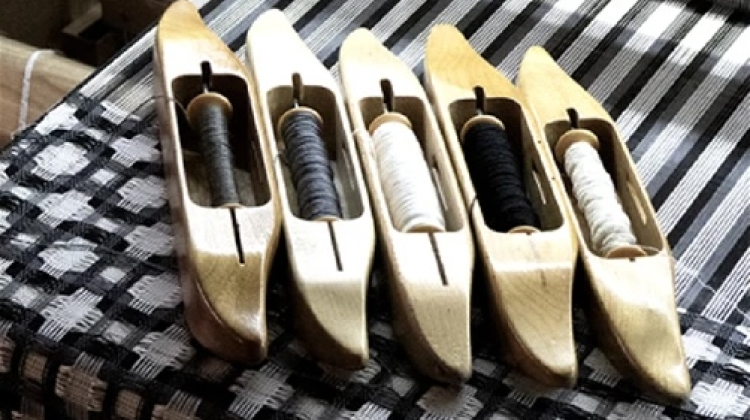Handweaving shows potential in robotic textiles

Fibers used to create a large-scale fabric on the dobby loom. Photo: Sarah Nicita
Liquid crystal elastomer fibers incorporated into different weave designs create programmable and reversible structures.
By Becky Ham
Weaving, one of the world’s oldest technologies, offers a framework for making cutting-edge robotic textiles curl, shrink, puff, and return to their original shapes, according to a recent study by MIT Media Lab researchers.
While much of the focus on shape-shifting textiles has been on developing new environmentally responsive active fiber types, the paper published in Nature Scientific Reports provides a guide for exploring the programmable possibilities of pairing these fibers with the knowledge honed over thousands of years by textile weavers.
The team led by Professor Hiroshi Ishii of the Media Lab’s Tangible Media group used weaving to demonstrate how differences in the features of each woven design—such as structure, tension, density, and material composition—can produce predictable and reversible actuated fabrics.
These kinds of textiles could be used to build soft, controllable robots, biomedical therapeutics, shape-changing garments that react to their wearer, or adaptable building materials, the researchers note.
“As someone with a background in textiles, I’ve always been impressed by the versatility and potential of different fabric manufacturing techniques,” explains Sarah Nicita, the study’s first author.
One way of thinking about the project, says study co-author James C. Weaver, “is that the work represents a very modern spin on a very ancient technology.”
LCEs and lace
This study works with shape-changing fibers called liquid crystal elastomers (LCE), which have been the subject of work led by co-author Jack Forman alongside a team of researchers from MIT and Northeastern University. LCE fibers combine long and flexible polymer chains with liquid crystal molecules, which can reversibly extend and contract when exposed to temperature changes. The LCE fibers used in the current study become active at 65 degrees C, allowing for fast, reversible shape changes.
The team used hand and digital looms to weave the LCE fibers with cotton and conductive thread, which gave precise control over the weaving variables needed to “program” the fabric to deform in specific ways.
“At a basic level, a woven structure involves a programmable horizontal element [the weft] and a programmable vertical element [the warp],” Nicita explains. “Each can be individually tuned to achieve different properties.”
Nicita created single-layer fabric variations such as space plain weave, Swedish lace and waffle weave, along with more complicated double-layer fabrics with different warp and weft features such as tie-downs and floats.
The researchers then used either external or internal heat sources to activate the LCE fibers and explore how different weaves generated different shape changes in the fabric.
The researchers also measured the mechanical forces generated during these shape changes. “Bringing together materials scientists and textile engineers to understand the complex behaviors of these fabrics was really exciting, as it allowed us to employ a wide range of tools like scanning electron microscopy, elemental mapping, and x-ray imaging, which added tremendous value to this research, and represent techniques essentially unknown within the fashion industry,” Weaver notes.
As a final application, Nicita used a dobby loom to create enough fabric for a full jacket that could puff and scrunch up its own sleeves. She drew design inspiration from the 1928 volume The Shuttle Craft Book of American Handweaving by Mary Meigs Atwater, a well-known historical reference.
"What excites me most about this work is that we are able to integrate electronically controllable shape change into textiles, while maintaining the soft look and feel that makes fabric such a loved and ubiquitous material. The fabrics look and feel ordinary but with augmented capabilities,” says Forman.
Beautiful continuity
The researchers say the weaving framework presented in the study demonstrates a beautiful continuity between a rich history of craft and a rich future of possibilities.
“In this case, the fabric features were not simply ornamental, but rather, they function as actuators, and that paradigm shift is really integral to seeing textiles as the future of robotics and robotic interfaces,” Nicita says.
Nicita now works at NASA on projects preparing for a return to the moon, “and a big part of textile and softgood engineering is designing materials that excel within the unique physics of space,” she says.
The high-tech applications haven’t dimmed her appreciation for the personal pleasures of weaving, she says.
“For me, hand-weaving these fibers shows that the same draft marks that have been used for thousands of years can now program a fabric to curl, breathe, or reshape itself on command. There’s magic in that—when something centuries old finds a voice in modern robotics.”


